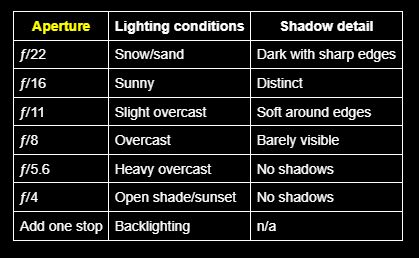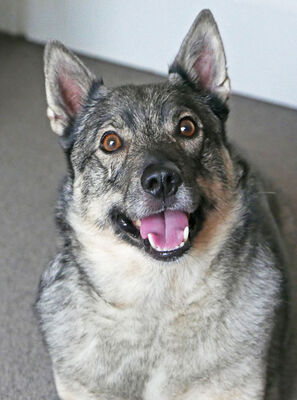ISO film setting on Mamiya RB67 Pro
Feb 12, 2024 12:58:11 #
JFCoupe wrote:
I recently was given a Mamiya RB67. I am interest... (show quote)
JF!
You need a light meter! Without one, you can use the "Sunny 16 Rule", see:
https://en.wikipedia.org//wiki/Sunny_16_rule
Use as the shuuter speed: 1/nearest number to ISO/ASA of film with recommended aperture in chart below.
Be well! Ed
Feb 12, 2024 14:16:34 #
Guy850
Loc: Connecticut
JFCoupe wrote:
You need a light meter to use with the Mamiya RB67 Pro.I recently was given a Mamiya RB67. I am interest... (show quote)
Feb 12, 2024 14:23:46 #
Retired CPO wrote:
Well. I think he has the answer to his question. But I think it should be clear that there was NO SUCH THING as ISO in those halcyon days. It was ASA only! And still should be!
Why?
They mean exactly the same thing.
Feb 12, 2024 14:33:14 #
Burtzy wrote:
As I recall from my film days, the basic exposure ... (show quote)
Actually the suggested exposure settings were printed on a thin bit of paper folded in the box of each roll of film.
The settings you quote only applied to 100ASA and there was a variety of different film 'speeds'. Ilford had a nice fine grain 50ASA film. I think their 400ASA was called HP4??
Flash was really no more complicated than it is today, except one did have to think about what you were doing.
Film and processing was expensive so each click of the shutter was important. No machine gunning techniques.
Feb 12, 2024 14:38:04 #
TonyP wrote:
Actually the suggested exposure settings were prin... (show quote)
I always threw out the paper in the film box. I had it all in my head. Still can't find my glasses.

Feb 12, 2024 14:55:49 #
JFCoupe wrote:
The one question I have is how do I set the ISO for the film. I have seen that there is 100 and 400 ISO film available in the 120 format.
The ISO you assume for the film depends on how it's going to be developed.
Take a look at The Massive Dev Chart for Kodak Tri-X. It shows anywhere from ISO 100 to ISI 6400 depending on the developer, concentration, time, temperature and agitation. Consider these assumptions as opinions, not fact. Look at the Notes in the last column.
I narrowed Tri-X down to between ISO 250 and 400 since I developed the film myself and I got to those values after careful testing.
But if you get your film developed in a lab, ISO 320 is probably a good place to start. If your negatives don't turn out the way you want them to you can change your assumption accordingly.
Feb 12, 2024 14:57:48 #
TonyP wrote:
Why?
They mean exactly the same thing.
They mean exactly the same thing.
Absolutely correct!

Feb 12, 2024 15:24:43 #
selmslie wrote:
The ISO you assume for the film depends on how it'... (show quote)
I/We developed and printed our own negatives but always just used the stated ASA for B & W. Was usually close enough unless we were in 'challenging' conditions. Just like today with Photoshop etc, we dodged and burned areas of the final print or left it in the developer bath longer, or shorter, to get pretty good final prints. There was quite a bit of latitude in B & W film.
Colour, when it came along, was a lot different. Not the same latitude and was expensive, so one REALLY had to think, before taking the shot. We used an outside Laboratory for years until the boss bought the gear to process it and employed the guy who had been doing it at the laboratory to do the processing.
Thank the gods of photography for digital aye?
Feb 12, 2024 15:49:37 #
You can set the ASA or DIN on your RB-67 if you have the CdS prism finder because this finder has a meter in it.
chrome-extension://efaidnbmnnnibpcajpcglclefindmkaj/https://ianbfoto.com/downloads/Mamiya%20RB67/Mamiya%20RB67%20CdS%20Prism%20Finder.pdf
KEH is selling one for $80 but.... the meter is broken
chrome-extension://efaidnbmnnnibpcajpcglclefindmkaj/https://ianbfoto.com/downloads/Mamiya%20RB67/Mamiya%20RB67%20CdS%20Prism%20Finder.pdf
KEH is selling one for $80 but.... the meter is broken
Feb 12, 2024 15:51:45 #
TonyP wrote:
I/We developed and printed our own negatives but always just used the stated ASA for B & W. Was usually close enough unless we were in 'challenging' conditions. ...
I switched to HP5 when Kodak's prices got a little too high. By then I had settled on Xtol as a developer that was easier to use than most others.

Feb 12, 2024 16:21:14 #
BebuLamar wrote:
You can set the ASA or DIN on your RB-67 if you have the CdS prism finder because this finder has a meter in it.
chrome-extension://efaidnbmnnnibpcajpcglclefindmkaj/https://ianbfoto.com/downloads/Mamiya%20RB67/Mamiya%20RB67%20CdS%20Prism%20Finder.pdf
KEH is selling one for $80 but.... the meter is broken
chrome-extension://efaidnbmnnnibpcajpcglclefindmkaj/https://ianbfoto.com/downloads/Mamiya%20RB67/Mamiya%20RB67%20CdS%20Prism%20Finder.pdf
KEH is selling one for $80 but.... the meter is broken
Yeah. But I dont think it is actually synchronised to the settings. Its just and expensive light meter. I'm sure to be corrected if wrong.
Feb 12, 2024 19:03:25 #
TonyP wrote:
Why?
They mean exactly the same thing.
They mean exactly the same thing.
Why not?!
Feb 12, 2024 23:05:00 #
Retired CPO wrote:
Why not?!
Oh. When you got so upset as to use capital letters in your statement, I thought you might have known what you were talking about.
Obviously not.
Well to answer your question; why not?
Because the world of photography doesn't revolve around America, like maybe it used to back in the days of film.
Today, ASA, the American Standards Association 'system' still refers to the amount of sensitivity film has to light.
It was when digital started to rear its convenient head, it was realised ASA wasn't going to have the range to cope with sensors that would eventually be a lot more sensitive to light than film.
That's when the International Organisation for Standards got involved and ISO was born.
25 ASA to maybe 800 ASA and today we already have sensors with sensitivity north of 13000 ISO.
To all intents and purposes ISO and ASA are the same, but there is a slight difference. I won't go into that aspect here as I cant actually remember what the diff is and it doesn't really matter.
Hope that answers your question CPO.
Cheers

Feb 13, 2024 05:13:11 #
TonyP wrote:
Oh. When you got so upset as to use capital letter... (show quote)
ISO were used way before there were digital cameras.
Feb 13, 2024 07:09:48 #
BebuLamar wrote:
ISO were used way before there were digital cameras.
Those of us who were around when it happened in 1974 knew that it was only an inconsequential change in the way that Film speed was labeled.
If you want to reply, then register here. Registration is free and your account is created instantly, so you can post right away.







